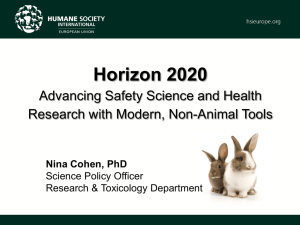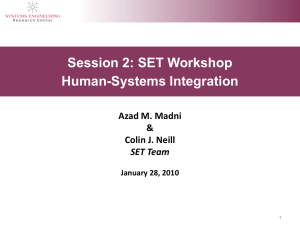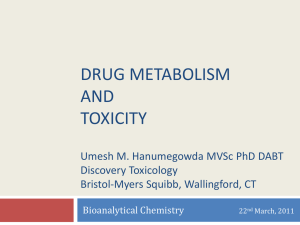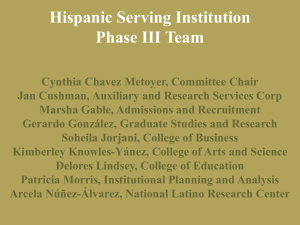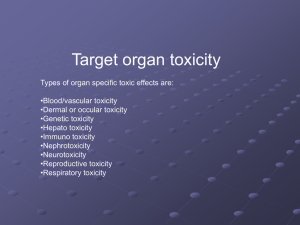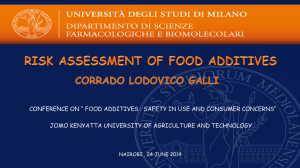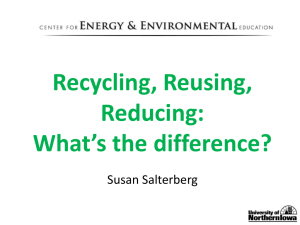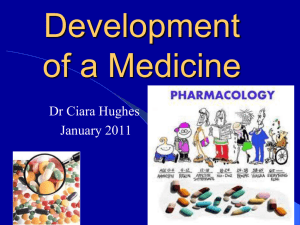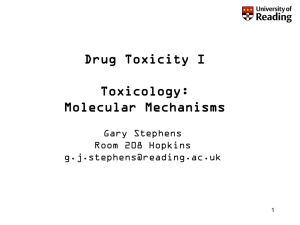The Development of the Three Rs Approach to Chemical Testing An
advertisement
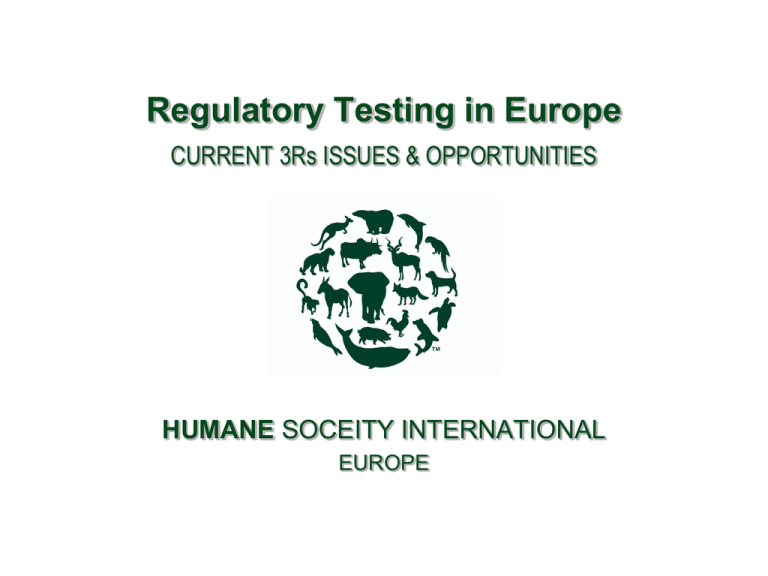
Regulatory Testing in Europe CURRENT 3Rs ISSUES & OPPORTUNITIES HUMANE SOCEITY INTERNATIONAL EUROPE About HSI Europe • HSI is the international arm of the Humane Society of the United States, the world’s largest animal protection organisation, with nearly 11 million supporters worldwide • HSI has a long history of building lasting partnerships with members of the regulatory and regulated communities for the furtherance of common goals • As do most scientists, HSI wants to see the day when no animal is used in harmful experiments, and regards the “3Rs” (replacement, reduction, refinement) as a win/win strategy for achieving this goal • HSI-Europe has been engaged in constructive dialogue with EU institutions, member states and industry since 1991 Committee/Expert Group Involvement • • • • • • REACH Competent Authorities Group ECHA Risk Assessment Committee USEPA Pesticide Program Dialogue Committee ILSI-US/Europe Steering Committees on TTC EPAA Mirror Group and Working Groups OECD Test Guidelines Programme – – – – Working Group of National Co-ordinators New design for reproductive toxicity studies Revision of chronic toxicity/carcinogenicity TGs Integrated approaches to testing and assessment • EPAA Mirror Group, Working Groups & Task Forces Why Deviate From Status Quo? • Low throughput and expensive • Multiplicity of in vivo tests for some toxicity endpoints • Many in vivo tests are between 50-80 years old and have never been subject to formal validation by contemporary standards – Reliable and relevant to humans? • Uncertainties associated with extrapolation – Inter- and intra-species, high to low dose, exposure durations, etc. • Methods have not kept pace with scientific progress • Animal welfare concerns – ~80% of the most invasive procedures are performed in the field of regulatory toxicology (CCAC, 2007) • Public opinion Case Study – Carcinogenicity • 18-24 months of chemical exposure + 2-3 years of data analysis • Multi-species design, consuming 400 rats + 400 mice at a cost of up to 3 million per chemical evaluated • Dubious reliability and relevance to humans, e.g.: – Poor (57%) concordance among >120 replicate studies – Numerous tumour types, organs, and mechanisms of action in rodents considered irrelevant to humans – Marked strain differences and high “background” tumour rates – Maximum tolerated dose (MTD) in rodents can be up to 100-times the equivalent daily intake for humans – Implausibly high rate of positive findings (false +ve classifications) (Gottmann et al., 2001; Cohen, 2004; IARC, 1995; 1999; 2003; Haseman, 2000, ACSH, 1997; Fung et al., 1995; Gold & Slone, 1993; Ennever et al., 1987) Case Study – Reproductive Toxicity • Several overlapping study designs prescribed as separate data requirements in one or more species: – 2-generation rat reproduction studies use upwards of 2,600 animals and cost as much as 300,000 – Prenatal developmental toxicity studies use 1,300 rats or 660 rabbits and cost between 34,000-50,000 – DNT studies use at least 1,300 rats at a cost of more than 300,000 • Dubious reliability and relevance to humans, e.g.: – Breeding a second generation adds little/no value to risk assessment – Poor (<70%) concordance among rats, mice and rabbits in detecting known teratogens – Use of a second species increases an already 40% false +ve rate (Derelanko & Hollinger, 2002; Cooper et al., 2006; Janer et al., 2007; Hurtt et al., 2003; Bremer et al., 2007; Schardein, 2000) Case Study – Acute Systemic Toxicity • • • • • WWI-era science; never formally validated Mortality or moribundity as the endpoint 5-40 animals killed per test, depending on test guideline Testing may be required by up to 3 routes (oral, inhalation, skin) Dubious reliability and relevance to humans, e.g.: – Rodent LD50 prediction of human lethal blood levels (R2 = 0.65) – “… even if the LD50 could be measured exactly and reproducibly, the knowledge of its precise numerical value would barely be of practical importance, because extrapolation from the experimental animals to man is hardly possible.” (Trevan, 1927; Ekwall et al., 1999; Lorke, 1983) Case Study – Agrochemicals Sector • Current costs of bringing a new pesticide to market can range from $152 to $184 million, consuming upwards of 12,000 animals for registration testing battery alone (ECPA/CLA, 2003; Mattsson et al., 2003) • As noted by the ILSI-HESI Task Force on Agricultural Chemical Safety Assessment: “In most cases, when the database is complete using the large number of animals mandated by the test guidelines, only one study is used to set the [reference dose] for each risk assessment. The question then arises: Would it have been possible to leave out the studies which were not used and still protect health?” (Doe et al., 2006) Case Study – Pharmaceuticals Sector • Current costs of bringing a new medicine to market can range from $0.8 to $1.7 billion, consuming upwards of 7,000 animals – 92% of drugs that pass preclinical testing fail clinical trials (Tufts Center for the Study of Drug Development, 2001; FDA, 2004) • As noted in the 2004 FDA Critical Path report: – “Currently available animal models, used for evaluating potential therapies prior to human clinical trials, have limited predictive value in many disease states.” – Traditional animal toxicology “… is laborious, time-consuming, requires large quantities of product, and may fail to predict the specific safety problem that ultimately halts development.” (FDA, 2004) Change Is Needed “It is simply not possible with all the animals in the world to go through new chemicals in the blind way that we have at the present time and reach credible conclusions about the hazards to human health. We are at an impasse. It is one with deep scientific roots and we had better do something about it.” –Dr Joshua Lederberg Nobel Laureate in Medicine (Chemical Engineering News, 1980) Short-Term Solution: The “3Rs” • The principle of reduction, refinement and replacement of animal use was first articulated in the 1959 publication, The Principles of Humane Experimental Technique, by British scientists William Russell and Rex Burch • During the subsequent half-century, tens of millions have been invested by corporations, governments and other stakeholders with the goal of advancing the 3Rs in research and testing The Road to Regulatory Acceptance Research & Development ? yrs Prevalidation ~2 yrs Regulatory Valid- Peer ation review acceptance (regional) ~1 yr ~1 yr ~2 yrs Regulatory acceptance (international) 3+ yrs Factors Affecting Progress • Lack of co-ordinated global strategy for prioritisation and funding of new test method R&D • Access to sufficient quantity and quality of (human-relevant) reference data for validation – Recent material transfer agreements between pharma companies and US EPA • Uneven acceptance of validated 3Rs methods – International validation criteria now harmonised, yet resistance continues in some regions • Trend toward new and complex in vivo data requirements – Developmental neuro-, immuno-, cardio-toxicity, endocrine, acute reference dose, etc. Is replacing animal tests one endpoint at a time a viable long-term strategy Long-Term Solution: Paradigm Shift • US National Academy of Sciences (NAS) Report “Toxicity Testing in the 21st Century” (2007): – Recognises that current approaches are not only cumbersome, but simply not optimal for toxicity testing in the 21st century – The NAS envisions “... a not‐so‐distant future where all routine toxicity testing will be conducted in human cells or cell lines in vitro by evaluating perturbations of cellular responses in a suite of toxicity pathway assays using rapid robotic‐assisted methodologies.” Current High Throughput Capabilities (US National Institutes of Health Chemical Genomics Center) # wells per plate, including controls 1,536 # chemicals per plate 1,408 # concentrations per chemical # assays Concentrations (including controls) x Assays x Wells Current NCGC capabilities Time needed to run 1,408 chemicals (~5 million wells) Cost per dose-response curve Cost per chemical (200 assays) Costs per 10,000 chemicals 15 200 ~5 million wells 2.5 million wells per week 2 weeks US$50 US$10,000 US$100 million Advantages of a High Throughput Paradigm 2-species cancer bioassay NCGC HTS platform Cost 2.5-3 million € 2.5 million € # chemicals 1 350 # animals 800+ 0 # endpoints ? ~200 Duration 150 weeks 1 week HSI Perspective on NAS Vision Implementation • HSI’s goal is a permanent end to animal testing worldwide • HSI welcomes ongoing 3Rs initiatives in the EU/US, but recognises the need for a much larger-scale research effort to make this vision a reality Toxicology’s equivalent to the Human Genome Project (“HUMAN TOXICOLOGY PROJECT”) • Funding target: 150M € per year over 10 years (total=1.5B €) – Public-private partnership between G8 countries and corporations • Goal: a targeted research programme that is: – Multi-year, multi-discipline and multinational • Current partners: – Corporate: Dow, Dupont, Exxon-Mobil, Johnson & Johnson, Procter & Gamble, Unilever – NGOs: HSI & its US affiliates – Research: Hamner Institutes for the Health Sciences • Aims: – Facilitate global implementation of the NAS report – Promote dialogue, information sharing & establishment of an R&D roadmap – Lobby for, coordinate & provide resources for transatlantic efforts – Urgently develop a targeted research program to jumpstart the transformation • The Project Accelerating the transition to a toxicity pathway-based paradigm for chemical safety assessment through internationally co-ordinated research and technology development •EU FP7 Coordination Action developed on the initiative of HSI • 3.5 year, >550,000 € project designed to fulfill the growing need of a focal point for co-ordination among 3Rs research projects in Europe as well as internationally • Partners • • Free University of Berlin (Horst Spielmann & Monika Schäfer-Korting) CARDAM-VITO (Greet Schoeters) The Project • AXLR8 will: – Organise a series of annual workshops to map research progress, gaps and needs in the FP6/FP7 programme on alternative testing strategies – Provide a range of tools and opportunities for enhanced interdisciplinary and international communication, co-ordination and collaboration in order to maximise the impact of available resources – Work to streamline regulatory acceptance procedures to provide for the uptake of validated 3Rs methods, including a smooth transition to 21st century systems as they become available – Produce annual progress reports on the state of the science, including recommendations on priority research and funding targets, in order to ensure a prominent role for European science in this rapidly developing global research area Thank You! For further information, contact: Emily McIvor Senior EU Policy Adviser Research & Toxicology Department +44 (0)7812 354 144 emcivor@hsi.org HSIEurope.org | AXLR8.eu

